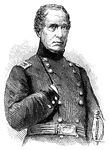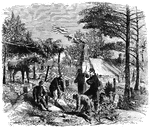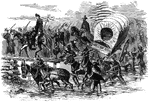
War in Louisiana
"The war in Louisiana. General Banks's army, in the advance on Shreveport, crossing Cane River, March…

War in Virginia
"The war in Virginia. General Butler's lines south of the James, Va., with troops in position near the…

Eighteenth Corps
"The war in Virginia. A regiment of the Eighteenth Corps carrying a portion of Beauregard's line in…

Capture of Lost Mountain
"The war in Georgia. Capture of Lost Mountain by General Hooker, June 16th, 1864. On June 14th General…

Sherman's Campaign
"Sherman's Campaign in Georgia- the attack of the Fourteenth, Sixteenth and Twentieth Army Corps on…

Siege of Petersburg
"The Siege of Petersburg, Va. Charge of the second division, Ninth Army Corps, into the crater, July…

Sheridan's Great Battle
"The war in Virginia- Sheridan's Great Battle with J. E. B. Stuart at Yellow Tavern, May 11th, 1864-…

Battle of Ream's Station
"The Siege of Petersburg. Battle of Ream's Station- the attempt of the enemy to regain the Weldon Railroad…

Howlett's Battery
"Howlett's Confederate Battery on the James River, Va., shelling the Federal monitors and laborers on…

Savannah, Georgia, Looking East
"View of Savannah, Ga., looking east, toward Fort Jackson. Savannah, the entry port of Georgia, is built…

Dutch Gap Canal
"Blowing out of the bulkhead of the Dutch Gap Canal, James River, Va., January 1st, 1865. At twelve…

Belle Isle
"View of Richmond, Va., from the prison camp at Belle Isle, James River. Belle Island is situated in…

Battle of Bentonville
"The Battle of Bentonville, N. C.- Major General Mower, commanding First Division, Seventeenth Corps,…
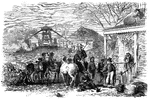
Bummers
"Sherman's 'Bummers' foraging in South Carolina. Our artist sent us with this sketch of 'Bummers Foraging'…
Sheridan's Campaign
"Sheridan's campaign in the Shenandoah Valley- the Federal forces falling back through Charlestown,…
Siege of Atlanta
"The Siege of Atlanta, Ga.- Confederate attack on General Logan's Corps, July 28th, 1864. The assailants…

Confederate Fort
"Ruins of Confederate fort on the southeast side of Atlanta, with chevaux-de-frise and abatis in front."—…
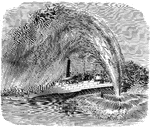
Commodore Barney
"The war in Virginia. Explosion of a torpedo under the Commodore Barney, on James River, August…

Fort Pawhatan
"The campaign on the James River- General Butler landing at Fort Pawhatan."— Frank Leslie, 1896
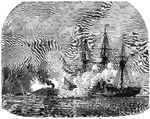
Mobile Harbor
"Farragut's naval victory in Mobile Harbor. The Hartford engaging the Confederate ram Tennessee.…

Battle of Resaca
"Battle of Resaca, Ga., May 14th, 1864. Geary's Second Brigade charging up the mountain."— Frank…

Buzzard's Roost
"Sherman's Campaign. The capture of Buzzard's Roost at Hovey Gap, Ga., May 8th, 1864. Among the strongholds…

Eighteenth Corps
"The war in Virginia, the Eighteenth Army Corps storming a fort on the right of the Confederate line…
!["The war in Virginia. The Twenty-second [African American] Regiment, Duncan's Brigade, carrying the first line of Confederate works before Petersburg. On the morning of the 15th of June, 1864, General Hinks formed his command in line of battle, and advanced upon the Confederates, with Duncan commanding his right and Holman his left. The result of this charge was waited for with great anxiety. The majority of the whites expected that the [African American] troops would run, but the sable forces astonished everybody by their achievements. With a wild yell that must have struck terror into the hearts of their foes, the Twenty-second and Fifth United States [African American] regiments, commanded by Colonels Kidder and Connor, charged, under a hot fire of musketry and artillery, over the Confederate ditch and parapet, and drove the enemy before them, capturing a large field-piece, and taking entire possession of their works, its defenders, Ferrybee's Fourth North Carolina Cavalry, and Graham's Petersburg Battery, seeking safety in rapid flight, leaving their dead and wounded in the works."— Frank Leslie, 1896](https://etc.usf.edu/clipart/11700/11799/duncan-brig_11799_mth.gif)
Duncan's Brigade
"The war in Virginia. The Twenty-second [African American] Regiment, Duncan's Brigade, carrying the…
!["Siege of Petersburg. The [African American] infantry bringing in captured guns and cheers of the Ohio troops. When the [African American] troops found themselves within the works of the enemy no words could paint their delight. Numbers of them kissed the guns they had captured with extravagant satisfaction, and a feverish anxiety was minfested to get ahead and charge some more of the Confederate works. A number of the [African American] troops were wounded and a few killed in the first charge. A large crowd congregated, with looks of unutterable admiration, about Sergeant Richardson and Corporal Wobey, of the Twenty-second United States [African American] regiment, who had carried the colors of their regiment and been the first men in the works. Our artist gives a sketch of this gallant action."— Frank Leslie, 1896](https://etc.usf.edu/clipart/11800/11801/petersburg_11801_mth.gif)
Siege of Petersburg
"Siege of Petersburg. The [African American] infantry bringing in captured guns and cheers of the Ohio…

Seventeenth Corps
"Sherman's Seventeenth Corps crossing the south Edisto River, S. C., on Pontoons, at Bennaker's Bridge,…
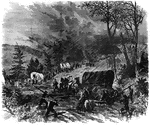
Campaign in Georgia
"The campaign in Georgia. A baggage train crossing the mountains in a storm. General Sherman, after…
!["Assault of the Second Louisiana [African American] Regiment on the Confederate works at Fort Hudson, May 27th, 1863. The Battle of Fort Hudson was a severe and well-fought action. The Federal troops displayed their usual bravery, and were well handled by General Banks, driving the enemy to his second line of works. Of the [African American] regiments General Banks, in his official report, says: 'They answered every expectation. Their conduct was heroic. No troops could be more determined or more daring. They made during the day three charges upon the batteries of the enemy, suffering very heavy losses, and holding their position at nightfall with the other troops on the right of our line. The highest commendation is bestowed upon them by all officers in command on the right. Whatever doubt may have existed heretofore as to the efficiency of organizations of this character, the history of this day proves conclusively to those who were in a condition to observe the conduct of these regiments that the Government will find in this class of troops effective supporters and defenders. The severe test to which they were subjected, and the determined manner with which they encountered the enemy leave upon my mind no doubt of their ultimate success. They require only good officers, commands of limited numbers, and careful discipline to make them excellent soldiers.'"— Frank Leslie, 1896](https://etc.usf.edu/clipart/11800/11805/ft-hudson_11805_mth.gif)
Fort Hudson
"Assault of the Second Louisiana [African American] Regiment on the Confederate works at Fort Hudson,…
Battle of Winchester
"Sheridan's Campaign- Battle of Winchester- position of the Nineteenth Corps, General Emory, September…
Winchester Charge
"Sheridan's Campaign. Battle of Winchester- charge of Crook's Eighth Corps, September 19th, 1864- the…
Confederate Army
"The Confederate army, under early, surprising the Federal forces at Cedar Creek, on the morning of…
Battle of Middletown
"Battle of Middletown, on the afternoon of the 19th of October, 1864. Great victory won by Major General…

Dog at Winchester
"Sheridan's Campaign- an incident at the Battle of Winchester- a faithful dog watching and defending…
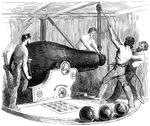
Loading Gun
"Loading a 15-inch gun in the turret of an ericsson ironclad during the attack on Fort Sumter."— Frank…

Blacksmith
"Scene in camp near Falmouth, Va. Army blacksmith shoeing a refractory mule."— Frank Leslie, 1896
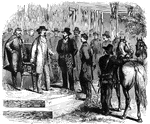
Siege of Vicksburg
"The siege of Vicksburg. General Grant meeting the Confederate General Pemberton at the Stone House,…
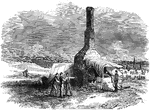
Cookhouse
"Army cookhouse constructed in an old chimney of an outhouse of the Lacy Mansion, on the Rappahannock,…

Kirby Smith
"Voluntary dispersion of Kirby Smith's Confederate army at Shreveport, La., May 23rd, 1865. There was…

Macon Railroad
"Sherman's campaign in Georgia- Federal forces at Jonesborough destroying the Macon Railraod."— Frank…

War in Georgia
"The war in Georgia. Wagon train passing Resaca at night. Our correspondent wrote: 'No general probably…
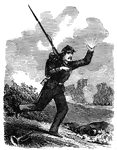
signal with glass
"Signaling with a piece of looking glass. Hints to Soldiers in the camp and on campaign."— Frank…
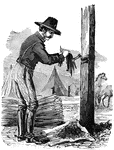
Chaff
"Cutting coarse forage into chaff. Hints to Soldiers in the camp and on campaign."— Frank Leslie,…
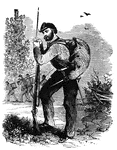
Water Skin
"Water skin and mode of carrying. Hints to Soldiers in the camp and on campaign."— Frank Leslie, 1896
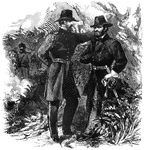
Battle of the Wilderness
"An incident of the Battle of the Wilderness. Lieutenant General Grant and Major General Meade in consultation,…
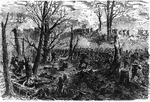
War in Tennessee
"The war in Tennessee. Capture of Mission Ridge, near Rossville, by General Thomas, November 25th, 1863.…
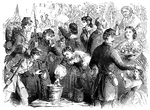
Daughters of Maryland
"How the Daughters of Maryland received the Sons of the North as they marched against the Confederate…

Georgia Campaign
"The campaign in Georgia- Federal troops foraging near Warsaw Sound."— Frank Leslie, 1896

Weehawken
"The ironclad Weehawken returning to fire a parting shot at Fort Sumter, after the bombardment,…
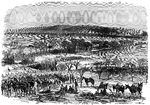
Kelley's Ford
"Kelley's Ford, on the Rappahannock, the scene of the Battle of the 17th of March, and of General Stoneman's…
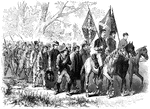
Confederate Prisoners
"Confederate Prisoners brought in after the Battle of Chancellorsville."— Frank Leslie, 1896
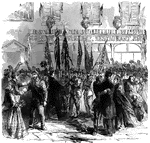
Soldiers Resting
"The soldier's rest--the friends of the Seventh and Eighth Regiments, New York Volunteers, welcoming…
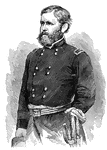
General William B. Franklin
"General William B. Franklin was a general in the Civil War."— Frank Leslie, 1896

Battle of Gettysburg
"Invasion of Pennsylvania- Battle of Gettysburg, Friday, July 3rd, 1863."— Frank Leslie, 1896


